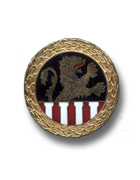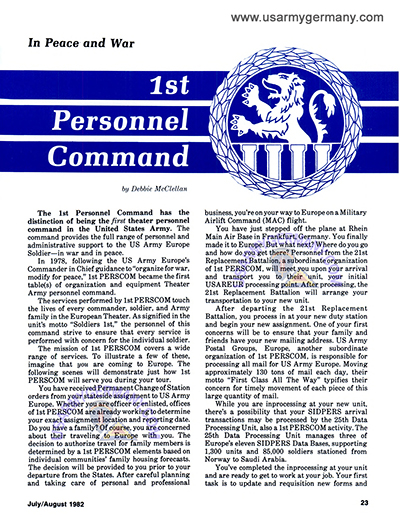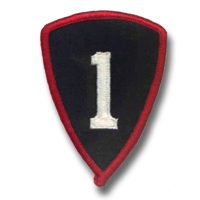If you do
NOT see the Table of Contents frame to the left of this page, then
Click here to open 'USArmyGermany'
frameset |
1st
Personnel Command
US Army, Europe
Looking for more information from military/civilian
personnel assigned to or associated with the U.S. Army
in Germany from 1945 to 1989. If you have any
stories or thoughts on the subject, please contact me . .
|
|
|
|
|
|
| History |
|
 1st Personnel Command DUI
1st Personnel Command DUI |
|
| 1982 |

Overview of the 1st Personnel Command, 1982 |
| |
| (Source: SOLDIER SUPPORT JOURNAL, JUL-AUG 1982)) |
|
|
| 1989 |
| (Source: Headquarters,
1st PERSCOM, 1989) |
THE HISTORY OF 1ST PERSONNEL COMMAND
The 1st Personnel Command (PERSCOM) as we know it today grew out of the experience of war. The United States Army was not adequately prepared for the Second World War. It was no surprise then that the Army's initial personnel and administrative systems in the European Theater were sorely deficient. By the time World War II ended, we had acquired a wealth of knowledge and experience. The personnel systems were supporting over 8 million U. S. soldiers in the Theater - hard to imagine when compared with the Theater strength today of 217,717.
The lessons learned then and since are being used today to shape an organization that can begin on the run.
There were many obstacles in supplying a war zone with personnel replacements for a force of 8 million. A rapid succession of military organizational structures devoted to personnel and administrative operations were created, eliminated, modified, or resurrected in different forms to meet mission changes and evolving requirements.
At the beginning of World War II there was no centralized Theater-wide replacement system. Experiments with the replacement system conducted in the United States in 1942 resulted in the activation of the first replacement depots and battalions that same year. 1st PERSCOM's own 21st Replacement Battalion was activated at that time. It is credited with participation in the battle campaigns of Naples, Rome, Southern France, and the Rhineland of Germany.
In October 1943, the Commander of the Services of Supply was directed to establish and operate a replacement system for the field forces. In November of that year, the Field Force Replacement System was established. Its headquarters was at Ben Hall Farms, Cheltenham, England.
On 10 June 1944, the Ground Force Replacement Command (European Theater) was established. This command operated directly under the Deputy Theater Commander and was charged with responsibility of replacements for all ground units. That command was a fore-runner of the replacement operations of the 1st Personnel Command. The geneological roots of 1st Personnel Command units came from a number of organizations.
Postal units have been in Europe for as long as the U.S. Army has been in Europe. Many of them received campaign credit for all of the major battles from Normandy to the Rhineland, and their decorations include Crosses of Gallantry and Presidential Unit Citations. The current parent organization, United States Army Postal Group, Europe (USAPGE), was organized in 1969 and is currently located at Rheinau Kaserne.
The United States Army Confinement Facility, Mannheim (USACF-M) was constructed and first occupied in early 1963. USACF-M serves as the main confinement facility in the European Command. The operational control of the USACF-M was transferred from the 21st Support Command to the 1st Personnel Command on 1 October 1985.
In 1974 the U.S. Army Military Personnel Center, Europe (MILPERCENEUR) was activated in order to integrate all Theater Army personnel management and administration elements into one organization. Included in MILPERCENEUR's charter was responsibility for management of various soldier-support services to include personnel information systems, postal operations, and recreation services.
Several years later MILPERCENEUR was deactivated, and in its place, on 20 October 1978, the 1st Personnel Command came into being. Its first commander was Brigadier General Robert M. Joyce. Its second commander, Brigadier General William G. O'Leksy, took command in April 1979. The third commander was Brigadier General Charles F. Briggs, who took command on 3 August 1983. He in turn passed the command to Brigadier General William H. Gourley, on 13 August 1984. On 23 October 1987, Major General Gourley passed the Colors to the current commander, Brigadier General Ronald E. Brooks.
1st PERSCOM is an organization that performs most of the functions in peace that it would be expected to perform at a time of war. There is one notable exception, during mobilization, several Army Reserve and National Guard units are assigned to 1st PERSCOM, the largest of which is the 800th Military Police Brigade (responsible for enemy prisoners of war). Under the CAPSTONE Program, this reserve component unit (USAR) based in Hempstead, New York, along with our other CAPSTONE units, have successfully participated in major war exercises here in Europe, proving beyond any doubt their readiness to assume their wartime mission at a moments notice.
1st Personnel Command is currently involved in the most broadly based participation in war exercises in its history. 1st PERSCOM's mission is real and critical to the Theater mission -- whether in war or peace. |
|
|
|
If you have more
information on the history or organization of the 1st PERSCOM, please
contact me . . |
|
| |
| (Source: Command
Briefing, Headquarters, 1st PERSCOM, 1989) |
The 1st Personnel Command (1st PERSCOM) was activated on 20 October 1978. It is a combat services support command dedicated to providing the full range of personnel and administrative support to the USAREUR soldier, in war and in peace.
1st PERSCOM acts as the agent of the Commander in Chief, USAREUR (CINCUSAREUR) for personnel services operations throughout the Theater Army in Europe. Organized to manage replacement operations as well as personnel and administrative services in a rapidly expanding environment, 1st Personnel Command provides the needed rapid reaction and close control during mobilization or actual hostilities. It provides the CINCUSAREUR the maximum degree of flexibility and responsiveness for personnel management and personnel administrative matters to accomplish USAREUR and Seventh Army's mission.
The services performed by 1st PERSCOM touch the lives of every commander, soldier, and their families in USAREUR. These examples highlight some of the important services that 1st PERSCOM provides:
a. Develops, coordinates, and executes Theater Army's war planning for personnel and administrative operations.
b. Manages administrative support operations, providing direct support to the Theater Army Headquarters, and general support to the Theater Army.
c. Provides financial and administrative management and technical support of the recreation services and sports programs.
d. Manages replacement operations, quantitative and qualitative distribution, and use of the enlisted force.
e. Operates the officer personnel management and distribution system.
f. Executes policies and established procedures at the Theater Army level for personnel services support in personnel management, personnel actions, personnel records keeping, and strength accounting.
g. Directs postal operations for the Theater Army, exercising operational control over mail movement into, from and within the Theater to insure timely service to soldiers, their families, the civilian workforce, and retirees.
h. Operates a Theater Army Headquarters ADP Services Center.
On 7 November 1978, 1st PERSCOM was authorized its own distinctive shoulder patch (a white arabic one on a field of blue, with a red border). This patch symbolizes 1st PERSCOM's place as the only Theater Army Personnel Command on the active rolls of the United States Army deployed overseas to perform personnel and administrative operations.
On 14 August 1981, the proposed design for 1st PERSCOM's own Distinctive Unit Insignia was approved. The round crest consists of 4 white pillars at the base and at the top a gold lion, all encircled by a gold wreath.
The lion adapted from the City of Schwetzingen's Coat of Arms refers to the unit's first home in the European Theater. The 4 pillars represent the 4. main areas of the 1st PERSCOM mission --- personnel, administrative management, morale support, and postal. The round crest framed by a gold wreath signifies the totality and denotes the quality of service provided to the commanders and soldiers of the Theater Army.
On 18 September 1981, 1st PERSCOM had its own unit motto approved. The Motto, "Soldiers 1st", signifies that 1st PERSCOM soldiers are "soldiers first" and that the "Soldier" is "1st" in the 1st Personnel Command. |
|
 |
|
|
| US
Army Special Services Agency, Europe |
|
| 1st Personnel
Command
|
|
|
| |
 |
|
|
Related Links:
1st Personnel
Command - official home page |
| |
|
 1st Personnel Command DUI
1st Personnel Command DUI
